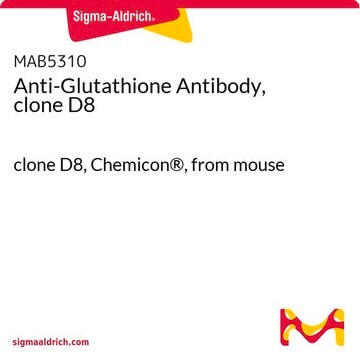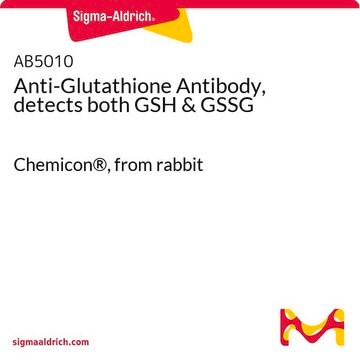MAB3194
Anti-Glutathione: N-ethylmaleimide adduct Antibody, clone 8.1GSH
clone 8.1GSH, Chemicon®, from mouse
About This Item
Produits recommandés
Source biologique
mouse
Niveau de qualité
Forme d'anticorps
purified antibody
Type de produit anticorps
primary antibodies
Clone
8.1GSH, monoclonal
Réactivité de l'espèce (prédite par homologie)
mammals
Fabricant/nom de marque
Chemicon®
Technique(s)
ELISA: suitable
flow cytometry: suitable
immunocytochemistry: suitable
immunohistochemistry: suitable
western blot: suitable
Isotype
IgG1
Conditions d'expédition
wet ice
Modification post-traductionnelle de la cible
unmodified
Spécificité
Immunogène
Application
Immunocytochemistry: 1:100 - 1:500 for assessment of intracellular GSH distribution.
ELISA: 1:100,000 - 1:200,000 to quantify GSH at >2 mM in biological specimens.
Flow cytometry: 1:100 - 1:1,000
Cells were fixed with cold 1% PFA for 5 min and vortexed into methanol (-20°C) containing 5mM NEM (10 min on dry ice) or 10 μM NEM (N-ethyl maleimide) for 30 min at RT.
Optimal working dilutions must be determined by end user.
Positive Control: Peripheral blood mononuclear cells (PBMC) treated with NEM
Neuroscience
Oxidative Stress
Forme physique
Stockage et stabilité
Autres remarques
Informations légales
Clause de non-responsabilité
Not finding the right product?
Try our Outil de sélection de produits.
Code de la classe de stockage
10 - Combustible liquids
Classe de danger pour l'eau (WGK)
WGK 2
Point d'éclair (°F)
Not applicable
Point d'éclair (°C)
Not applicable
Certificats d'analyse (COA)
Recherchez un Certificats d'analyse (COA) en saisissant le numéro de lot du produit. Les numéros de lot figurent sur l'étiquette du produit après les mots "Lot" ou "Batch".
Déjà en possession de ce produit ?
Retrouvez la documentation relative aux produits que vous avez récemment achetés dans la Bibliothèque de documents.
Notre équipe de scientifiques dispose d'une expérience dans tous les secteurs de la recherche, notamment en sciences de la vie, science des matériaux, synthèse chimique, chromatographie, analyse et dans de nombreux autres domaines..
Contacter notre Service technique






